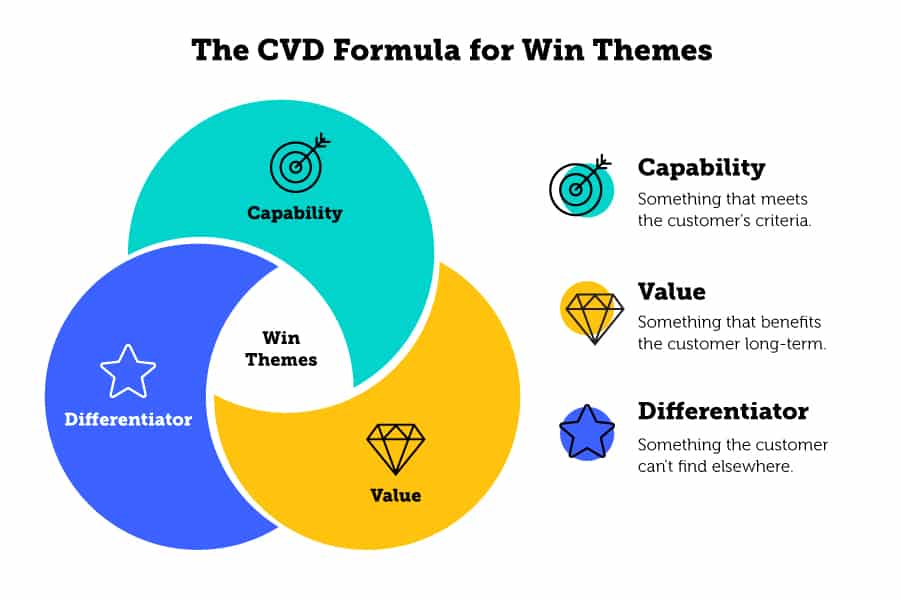How to Create Compelling Win Themes (Steal This Simple Formula)
Submitting a proposal without win themes is like showing off a trophy case full of participation ribbons. The evaluator will see you’ve made the effort, but there won’t be anything that makes you stand out as a front runner.
That’s why it’s crucial to brainstorm win themes as one of your RFP response process steps–ideally before you create a content plan. In doing so, you’ll be able to provide a clear vision of why your company is the best choice, which you can strategically weave into the proposal narrative.
In this article, we’ll show you how to develop strong win themes that will take your proposals from “just okay…” to “…okay, let’s sign the deal now!” Read on to learn:
- What Win Themes Are In a Proposal
- How Many Win Themes to Include
- How to Create Good Win Themes
- A Simple Formula for Win Themes (Steal This)
- How to Wrap Up Your Final Win Themes
What Exactly Are Win Themes?
As part of your proposal strategy, win themes are high-level statements that inform the underlying message of your response. They describe why your solution is the number one choice based on your strategic advantage beyond the RFP requirements.
“You can think of win themes as your single sentence strategy summaries,” explains Corinne Jorgenson, Senior Writer of Dragonfly Editorial. “If an evaluator were to read nothing but a collection of your win themes, the statements should be informative and compelling enough for the evaluator to make an educated decision about why your offer meets their needs better than any other offer. Using only that information.”
Corinne also notes that win themes are important for preparing the proposal collaboratively. While the primary purpose of win themes is to help the customer understand why they should pick you over the competition, they also unite your RFP team on how to win the contract. The results? A clear, consistent, and convincing proposal.
How Many Proposal Win Themes Should You Have?
While the jury is still out on exactly how many win themes a proposal should have, it’s best to include between one and three. If you use more than that, your message will seem confusing, not just to the evaluator but to your proposal writers and subject matter experts (SMEs) who have to package the content.
Just remember, it’s not how many win themes your proposal has but whether you target what the customer actually wants. In other words, don’t use a cookie-cutter theme to reach a certain number. Instead—if you can only come up with one, repeat it in a different way throughout the proposal by focusing on a new benefit each time.
“Bundling bland items together is perfectly acceptable,” assures Ben Klein, Consultant of Geek Proposals, “I saw a great one recently where they took a picture of the buyer’s office and their office doors, located half a block away from each other. The win theme was ‘We are the closest partner you will ever have.’ Every narrative was based on quick response, attentive service, and a merger of neighbours.”
Types of Win Theme Examples
Build a win theme from one of these buckets 🪣
✓ Hot Button Issue: A pain point the customer is looking to solve–ASAP.
✓ Ultimate Goal: An aspiration the customer is hoping to achieve (with your help).
✓ Big Deal Maker: A weakness you flip into a strength to continue negotiations.
How to Create a Good Win Theme
Win themes pack a lot of punch. In one sentence, they determine the entire positioning of your proposal while guiding your RFP team as they craft a compelling response. If you don’t get them right, you’ll be left with lose themes–something that’s vague, bland, and incompliant. So, what makes a good win theme? Here are some things to keep in mind:
-
Be Super Specific
It’s hard to commit to a win theme when you don’t know what it really means. Saying you’re “Superior,” “Seamless,” or “Robust” will only lead to the question, “How?” And if your RFP team doesn’t fully understand, they will struggle to answer that clearly in the proposal. Not to mention, the evaluator will filter it out as fluff.
-
Focus on Reality
Some RFP teams lose touch with reality by falling into the trap of creating win themes that are overly ambitious. Win themes must be grounded in what your company can successfully provide the customer right now–not a fantasy solution for the future. Think long-term: If you get the contract but fail to deliver, you won’t likely win the renewal.
-
Put the Customer First
Though proposals seem like a perfect opportunity to show off, it’s important to remember that if you’re presenting the customer with something they aren’t looking for, they’re not going to care. Instead, make them the hero by acknowledging their concerns and what you can do to help, even if it means your best features take a back seat.
-
Back it Up With Proof
The best win themes come with undeniable (and jaw-dropping) evidence. By supporting your claims with customer results, aggregated data, or survey statistics, you add a layer of credibility to your win themes while grabbing the attention of evaluators. Psst…a % or $ value has a way of jumping out on the page to proposal skimmers. 🤫
👉 Steal This Win Theme Formula
Quickly coming up with a win theme just to check it off your RFP response checklist is not the right approach. You can’t simply set aside a few minutes in your proposal kickoff meeting to “throw spaghetti at the wall and see what sticks.” That’s a one-way ticket to superficial positioning.
Win themes must be well-thought-out like your RFP answers. You create them methodically at the beginning of your proposal development process by finding the sweet spot between compliant and compelling. Easier said than done when you’re starting from scratch. So, what’s a simple way? Follow the CVD formula, which stands for:
C – Capability: Something that meets the customer’s criteria.
V – Value: Something that benefits the customer long-term.
D – Differentiator: Something the customer can’t find elsewhere.

We’ll show you how to use the CVD formula by workshopping a win theme together. The example? A solar project is underway and the energy company needs to start “cutting the grass” before it turns into fire fuel. Let’s get started.
Capability: Meet the Customer’s Criteria
After going through your RFP evaluation process, you should have a general idea of your company’s qualifications. Still, you’ll want to revisit the requirements to get a deeper understanding of the customer’s must-haves. (This insight will help you answer, “Can we do this?” more specifically to create a solid foundation for your win themes).
So, read through the request for proposal again. This time, pay extra attention to what the customer seems focused on overall for one of the win theme buckets. Then, analyze your ability to meet their decision criteria based on what you can offer.
| Hot Button Issue | Maintain vegetation under solar panels |
|---|---|
| Decision Criteria |
|
| Your Capability |
|
Value: Zero in on the Benefits
Features are fantastic for appeasing the RFP requirements side, but benefits tell the story in your proposal. Now that you know what you can offer, you’ll want to figure out why it’s valuable to the customer. After all, they’ll be thinking, “What’s in it for me?“
The best way to unpack your company’s overall value is to put your competence up against the “So What? Test” (a tactic borrowed from copywriters). The idea is simple: describe the benefit your prospect can expect from each capability, then answer why it really matters to them.
| Your Capability |
|
|---|---|
| The Benefit |
|
| Overall Value (So What?) |
|
Proposal Bonus: If you have a direct line to a key decision-maker, ask if you can hop on a discovery call to tease out what they’re specifically looking for (and why) since they have the check-signing power. Don’t have that luxury? Show up prepared with insightful questions to ask during the RFP process.
Differentiator: Identify Your Star Quality
It’s safe to bet you’ll have competitors who propose similar solutions. Rather than rehashing the same message and letting the decision come down to price, or worse, a game of “eeny, meeny, miny, moe,” you’ll want to find a competitive advantage to help your proposal stand out.
So, pull out your spy glasses and see what information you can pull up about your top two competitors–whether through their website, an independent review platform like G2, or even a client’s past RFPs from them. Then, put them side by side to compare. Ask yourself: What are their major gaps where our solution is superior?
| Competitor #1 |
|
|---|---|
| Competitor #2 |
|
| Your Differentiator |
|
If you’re not a clear winner anywhere, skip to the Big Deal Maker bucket and flip your weak points into win themes.
“This could be your business size,” says Eileen Kent, President of Custom Keynotes. “Address the elephant in the room by talking about how you formed a tight team who have exceeded performance expectations, and worked together for years, so they see that as a strength instead.”
How to Wrap Up Win Themes for Proposals
Now that you’ve identified your key points through the CVD formula, it’s time to sum it all up into compelling win themes. Simply combine items from each chart into one sentence. Here’s what we came up with:
✓ With 8,000 sheep, we can manage weeds 24/7, rain or shine, while we keep an eye on everything right next door.
✓ Through sheep grazing, you can maintain good relations with environmental organizations by capturing 7,000 tonnes of CO2 emissions and contributing up to 35% of soil organic matter.
✓ From farming the land for 115 years, we can adapt to unexpected vegetation problems or enlist the knowledge of our neighbourly land owners when necessary.
From here, you can wrap up this messaging with a nice bow and prepare your proposal. 🎁
-
Make a Content Plan (Storyboard)
There’s no point in having win themes if they get left out of the individual write-up. As you construct your proposal narrative, make sure that each section revolves around a win theme so that when you hand it off to your proposal writers, they know what to focus on and where.
-
Build Your Value Propositions
Take your win themes a step further by turning them into value propositions. By digging into more specifics, you can use a value proposition to expand on your win themes so it’s clear what your solution is, which will entice the evaluator to keep reading. Each section of your proposal should start with one.
-
Loop in Your RFP Contributors
Finally, announce your win themes at your kickoff meeting. Give your RFP team a little background on how you came up with the final direction and ask for their feedback. When everyone’s aligned, send them on their way to prepare the proposal with the win themes in tow.
Want to keep your win themes on hand during the RFP process?
Download this RFP checklist template to remind yourself the key messaging as you go through the RFP process steps.





